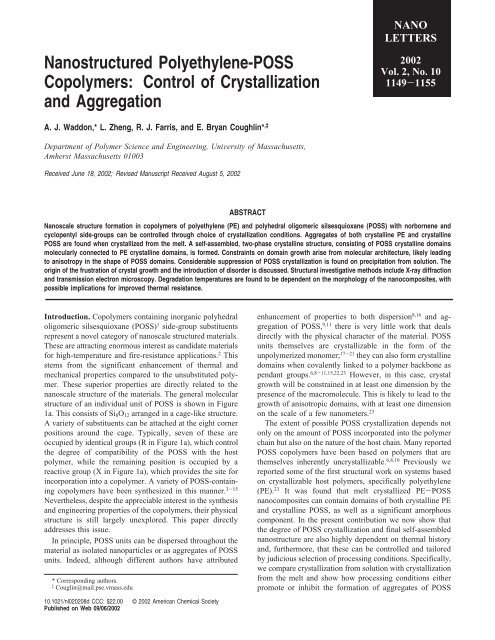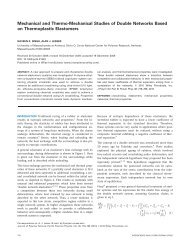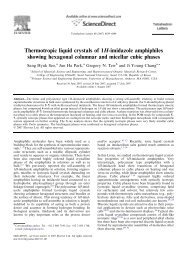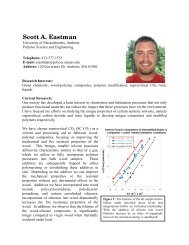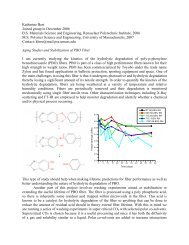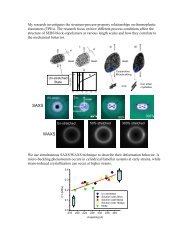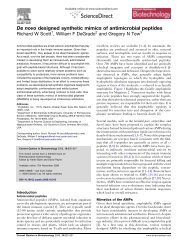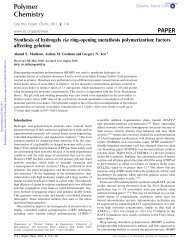Nanostructured Polyethylene-POSS Copolymers - Polymer Science ...
Nanostructured Polyethylene-POSS Copolymers - Polymer Science ...
Nanostructured Polyethylene-POSS Copolymers - Polymer Science ...
Create successful ePaper yourself
Turn your PDF publications into a flip-book with our unique Google optimized e-Paper software.
<strong>Nanostructured</strong> <strong>Polyethylene</strong>-<strong>POSS</strong><strong>Copolymers</strong>: Control of Crystallizationand AggregationNANOLETTERS2002Vol. 2, No. 101149-1155A. J. Waddon,* L. Zheng, R. J. Farris, and E. Bryan Coughlin* ,‡Department of <strong>Polymer</strong> <strong>Science</strong> and Engineering, UniVersity of Massachusetts,Amherst Massachusetts 01003Received June 18, 2002; Revised Manuscript Received August 5, 2002ABSTRACTNanoscale structure formation in copolymers of polyethylene (PE) and polyhedral oligomeric silsesquioxane (<strong>POSS</strong>) with norbornene andcyclopentyl side-groups can be controlled through choice of crystallization conditions. Aggregates of both crystalline PE and crystalline<strong>POSS</strong> are found when crystallized from the melt. A self-assembled, two-phase crystalline structure, consisting of <strong>POSS</strong> crystalline domainsmolecularly connected to PE crystalline domains, is formed. Constraints on domain growth arise from molecular architecture, likely leadingto anisotropy in the shape of <strong>POSS</strong> domains. Considerable suppression of <strong>POSS</strong> crystallization is found on precipitation from solution. Theorigin of the frustration of crystal growth and the introduction of disorder is discussed. Structural investigative methods include X-ray diffractionand transmission electron microscopy. Degradation temperatures are found to be dependent on the morphology of the nanocomposites, withpossible implications for improved thermal resistance.Introduction. <strong>Copolymers</strong> containing inorganic polyhedraloligomeric silsesquioxane (<strong>POSS</strong>) 1 side-group substituentsrepresent a novel category of nanoscale structured materials.These are attracting enormous interest as candidate materialsfor high-temperature and fire-resistance applications. 2 Thisstems from the significant enhancement of thermal andmechanical properties compared to the unsubstituted polymer.These superior properties are directly related to thenanoscale structure of the materials. The general molecularstructure of an individual unit of <strong>POSS</strong> is shown in Figure1a. This consists of Si 8 O 12 arranged in a cage-like structure.A variety of substituents can be attached at the eight cornerpositions around the cage. Typically, seven of these areoccupied by identical groups (R in Figure 1a), which controlthe degree of compatibility of the <strong>POSS</strong> with the hostpolymer, while the remaining position is occupied by areactive group (X in Figure 1a), which provides the site forincorporation into a copolymer. A variety of <strong>POSS</strong>-containingcopolymers have been synthesized in this manner. 3-15Nevertheless, despite the appreciable interest in the synthesisand engineering properties of the copolymers, their physicalstructure is still largely unexplored. This paper directlyaddresses this issue.In principle, <strong>POSS</strong> units can be dispersed throughout thematerial as isolated nanoparticles or as aggregates of <strong>POSS</strong>units. Indeed, although different authors have attributed* Corresponding authors.‡ Couglin@mail.pse.vmass.eduenhancement of properties to both dispersion 8,16 and aggregationof <strong>POSS</strong>, 9,11 there is very little work that dealsdirectly with the physical character of the material. <strong>POSS</strong>units themselves are crystallizable in the form of theunpolymerized monomer; 17-21 they can also form crystallinedomains when covalently linked to a polymer backbone aspendant groups. 6,8-11,15,22,23 However, in this case, crystalgrowth will be constrained in at least one dimension by thepresence of the macromolecule. This is likely to lead to thegrowth of anisotropic domains, with at least one dimensionon the scale of a few nanometers. 23The extent of possible <strong>POSS</strong> crystallization depends notonly on the amount of <strong>POSS</strong> incorporated into the polymerchain but also on the nature of the host chain. Many reported<strong>POSS</strong> copolymers have been based on polymers that arethemselves inherently uncrystallizable. 6,8,10 Previously wereported some of the first structural work on systems basedon crystallizable host polymers, specifically polyethylene(PE). 23 It was found that melt crystallized PE-<strong>POSS</strong>nanocomposites can contain domains of both crystalline PEand crystalline <strong>POSS</strong>, as well as a significant amorphouscomponent. In the present contribution we now show thatthe degree of <strong>POSS</strong> crystallization and final self-assemblednanostructure are also highly dependent on thermal historyand, furthermore, that these can be controlled and tailoredby judicious selection of processing conditions. Specifically,we compare crystallization from solution with crystallizationfrom the melt and show how processing conditions eitherpromote or inhibit the formation of aggregates of <strong>POSS</strong>10.1021/nl020208d CCC: $22.00Published on Web 09/06/2002© 2002 American Chemical Society
Figure 1. (a) Generalized structure of single <strong>POSS</strong> monomer unit 23 , (b) specific structure of norbornene-cyclopentyl <strong>POSS</strong> used in thisstudy.Table 1: Molecular Characterization of PE-co-<strong>POSS</strong><strong>Copolymers</strong> asample<strong>POSS</strong> incopolymers(wt %)<strong>POSS</strong> incopolymers(mol %)M w(×10 3 g/mol)polydispersityindexPE 0 0 328 1.26PE-<strong>POSS</strong>1 19 0.64 315 1.43PE-<strong>POSS</strong>2 27 1.0 315 1.67PE-<strong>POSS</strong>3 37 1.6 516 1.73PE-<strong>POSS</strong>4 56 3.4 446 2.07a Gel permeation chromatography was performed using a <strong>Polymer</strong>Laboratories high-temperature GPC PL-220 equipped with a Wyatt hightemperaturelight scattering detector miniDAWN (HTmD) at 135 °C intrichlorobenze. The miniDAWN detector contains a 690 nm diode laser.We used values of -0.104 for the dn/dc of polyethylene.nanocrystals. The nanoscale structure is demonstrated toradically change the physical nature and thermal degradationbehavior of the final material.Materials. A cyclopentyl-<strong>POSS</strong>-norbornenyl monomer1-[2-5-norbornen-2-ylethyl]-3,5,7,9,11,13,15-heptacyclopentylpentacyclo[9.5.1.1 3,9 .1 5,15 .1 7,13 ] octasiloxane, containingseven cyclopentyl and one norbornenyl group at thecorner positions, was obtained from Phillips Laboratory,Propulsion Directorate, Edward’s AFB. The specific structureof this particular monomer is shown in Figure 1b. Themonomer starts to decompose or sublime with onset temperaturesof ∼300 and 220 °C in nitrogen and air, respectively.No melting was detected below these temperatureswith standard differential calorimetry procedures. The norbornenylgroup was used as the reactive site to incorporate<strong>POSS</strong> as side units on a PE host polymer, as described inref 24 using a metallocene catalyzed reaction. “Assynthesized”materials were recovered after synthesis byprecipitation in methanol at room temperature. A series of<strong>POSS</strong>-PE copolymers of varying <strong>POSS</strong> contents wereprepared in this manner. The exact mole fractions and weightfractions of <strong>POSS</strong> are shown in Table 1. It should be notedthat, although the mole fractions are relatively low, theweight fractions are considerably higher (a consequence ofthe high molecular weight of the <strong>POSS</strong> unit). 1 H and 13 CNMR characterization indicated no significant residual <strong>POSS</strong>monomer content in these copolymers. Unfortunately, informationregarding precise sequence distribution is notavailable. For comparison, we also conducted structuralstudies on both PE homopolymer and on the unpolymerizedcyclopentyl-<strong>POSS</strong>-norbornene monomer material. However,because of low reactivity, it was not possible to synthesizethe homopolymer of <strong>POSS</strong>.Experimental Section. <strong>POSS</strong>-PE <strong>Copolymers</strong> and PEHomopolymer. Solution Crystallization. As-synthesized copolymersand PE homopolymer were dissolved in hot xyleneto form solutions of 0.2% (wt/vol) and subsequently cooledto room temperature. Only slight precipitation of copolymersoccurred on cooling, the amount of precipitation increasingwith increasing PE content. Full precipitation was inducedby the addition of acetone. The precipitates were dried toform films for examination by wide-angle X-ray diffraction(WAXD). Specimens were also prepared for transmissionelectron microscopy (TEM) by drying the suspensions ofprecipitates directly on carbon-coated TEM grids.Melt Crystallization. As-synthesized copolymers and homoPE were compression molded at 180 °C for 10 min andcooled to room temperature, as previously described. 23 Themelting temperatures of polyethylene in these copolymersare in the range of 100-130 °C.<strong>POSS</strong> Monomer. Solution Crystallization. <strong>POSS</strong> monomerwas found to be readily soluble in xylene, even at roomtemperature. In marked contrast to the <strong>POSS</strong>-containingcopolymers, this failed to precipitate from xylene solutionon addition of acetone. Specimens for TEM were thereforeprepared by depositing the xylene solution directly on carboncoatedgrids and allowing the solvent to evaporate.Methods of Investigation. The crystalline nature of bothsolution and melt crystallized materials were characterizedby X-ray diffractometry using a Siemens D500 diffractometeroperating in normal-transmission mode with Ni filteredCuKR radiation.Solution crystallized materials on carbon-coated TEMgrids were obliquely shadowed with gold. In some casescalibration polystyrene latex spheres of 0.87 µm were also1150 Nano Lett., Vol. 2, No. 10, 2002
Figure 2. Diffractograms of “as-synthesized” PE-<strong>POSS</strong> copolymers,“as-synthesized” PE homopolymer, and “as-received” <strong>POSS</strong>monomer.deposited on grids prior to shadowing. Grids were examinedin a JEOL 100CX TEM, operating at an accelerating voltageof 100 kV.Thermogravimetric analysis was carried out using a TAInstruments TGA 2050 thermogravimetric analyzer with aheating rate of 20 °C/min from room temperature to 700 °Cunder a continuous air purge of 50 mL/min.Results. The diffractograms of the initial as-synthesizedcopolymers are shown in Figure 2. For comparison, resultsfrom as-synthesized homo PE and as-received <strong>POSS</strong> monomerare also shown. It is apparent that the traces from thecopolymers show crystalline features characteristic of bothPE homopolymer and <strong>POSS</strong> monomer: (a) crystalline PEpeaks at 21.6° (equivalent to an interplanar spacing of 0.411nm), 24.1° (0.37 nm), and 36.5° (0.25 nm), correspondingto 110 PE , 200 PE , and 020 PE , respectively. These peaks broadenin the copolymers compared to homo PE. (b) crystalline<strong>POSS</strong> peaks at ∼8.2° (1.08 nm), evident in all copolymers,and at 11.0° (0.8 nm), evident in the material of highest <strong>POSS</strong>content. Both these signals can be unambiguously identifiedas originating from crystalline <strong>POSS</strong>. Although the peak at∼19.7° (0.45 nm) is close to the expected position for the010 of the PE monoclinic modification, it also correspondsto the position of a major <strong>POSS</strong> signal, and, because thisintensifies with <strong>POSS</strong> content, it is considered that this isprobably a contribution from crystalline <strong>POSS</strong>.The corresponding diffractograms for the materials precipitatedfrom solution are shown in Figure 3. For ease ofcomparison, the diffractogram from the as-received <strong>POSS</strong>monomer is also reproduced here and in Figure 4. It isimmediately apparent that all the copolymer traces aresignificantly different from those of the as-synthesizedmaterials in that they are dominated by the PE crystallinecomponent with weaker and significantly broadened <strong>POSS</strong>Figure 3. Diffractograms of PE-<strong>POSS</strong> copolymers and PEhomopolymer; precipitated from xylene solution by addition ofnonsolvent. (Trace from “as-received” <strong>POSS</strong> monomer also shown.)Figure 4. Diffractograms of PE-<strong>POSS</strong> copolymers and PEhomopolymer; crystallized by cooling from the melt at 180 °C.(Trace from “as-received” <strong>POSS</strong> monomer also shown.)peaks. On inspection it is also apparent that the PE reflectionsin the copolymers are broader in comparison to the homoPE.These results also contrast strikingly with the diffractometertraces for the melt crystallized materials of the samecopolymers, Figure 4. Here it is seen that the contributionfrom crystalline <strong>POSS</strong> is far stronger and that, for thematerial with highest <strong>POSS</strong> content, the <strong>POSS</strong> reflectionsdominate and PE reflections appear very broad and veryweak.Nano Lett., Vol. 2, No. 10, 2002 1151
Table 2: Apparent Crystal Sizes, L, of <strong>POSS</strong> CrystalsEstimated from the fwhm of the X-ray Reflection at 2θ ) 8.2°Using the Scherrer EquationsamplesolutioncrystallizedL, nmmeltcrystallizedPE-<strong>POSS</strong>3 3 7PE-<strong>POSS</strong>4 5 11<strong>POSS</strong> monomer 22Figure 5. Transmission electron micrograph (bright-field) of crystalof <strong>POSS</strong> monomer precipitated from xylene solution by evaporationof solvent. Gold shadowed.More information regarding the underlying microstructurein the xylene crystallized materials is obtained by directmorphological examination using TEM. Figure 5 shows amicrograph of the <strong>POSS</strong> monomer precipitated from xylene.This is dominated by well-formed crystals a few micrometersin length and, from shadow length measurement, a few tensof nanometers in thickness. The abundance of reentrantcorners, which leads to a “star” shape, is suggestive of crystaltwinning, although this is not an issue further developed here.Electron diffraction patterns consisting of spots were obtainedand obviously emanate from single crystals. A variety ofpatterns, corresponding to projections along different crystallographicaxes, were found. Importantly, the observedspacings were consistent with values previously found withX-ray diffraction, confirming the identification of the crystalsas <strong>POSS</strong>.Figure 6 shows an electron micrograph of the PE homopolymer(Figure 6a) and electron micrographs of thecopolymers (Figure 6 b-e), crystallized from xylene in allcases. In contrast to Figure 5 above, an abundance ofaggregates of small crystals is observed. Moreover, withincreasing <strong>POSS</strong> content, the morphology of the crystalsbecomes more poorly defined. Crucially, electron diffractiontypically comprised hk0 reflections from the PE lattice,identifying the aggregates as PE crystallites, oriented withthe chain axis parallel to the electron beam (and henceparallel to the thin dimension of the crystal).Separate <strong>POSS</strong> crystals are difficult to identify with anycertainty in these micrographs. Also, complimentary directmicroscopy evidence on the melt crystallized series was notreadily available due to the inherent difficulties in preparingthin sections. However, apparent <strong>POSS</strong> crystal sizes can beestimated indirectly from the relative broadening of the main<strong>POSS</strong> X-ray diffraction peak at 2θ ) 8.2° using the Scherrerequation (L ) λ/(β cos θ), where L is the apparent crystalsize, λ is the X-ray wavelength, and β is the full width athalf-maximum (fwhm) of the peak. Table 2 shows estimatesof L estimated from values of β for this reflection (usedwithout correction for instrumental broadening) for samplesin which β could be reasonably estimated. Of course,broadening can also be caused by crystal disorder effectswhich may also be significant here; furthermore, a highlyanisotropic crystal will show different values of β dependingon which reflecting crystallographic plane is used in thecalculation. This makes the estimation of absolute crystalsizes from the Scherrer equation inherently unreliable, andvalues of L should rather be considered as “apparent crystalsizes”. The apparent crystal size calculated for the monomeris much lower than lateral size indicated by microscopy(Figure 5) but is of the same order as the crystal thicknessestimated from shadow lengths. Table 2 also shows thatapparent crystal sizes in the copolymers are smaller than inthe monomer, that they decrease with decreasing <strong>POSS</strong>content, and are significantly larger in the melt crystallizedseries than in the solution crystallized series.Discussion. Clearly different crystallization procedures canproduce dramatic differences in final copolymer structure.For both solution and melt crystallization the startingmaterials were the as-synthesized materials, precipitated frommethanol. From WAXD the as-synthesized materials showedcrystalline populations of both PE and <strong>POSS</strong> at all levels ofloading. However, subsequent thermal treatment is seen toradically modify the crystalline structure.On precipitation from xylene, crystallization of PE dominateswith only a very minor degree of <strong>POSS</strong> crystallization.The reasons for this lie in the details of the crystallizationprocedure. The PE component will unquestionably dissolvein xylene at high temperature. Moreover, the ready solubilityof the <strong>POSS</strong> monomer in xylene at room temperaturesuggests that <strong>POSS</strong> crystals in the as-synthesized copolymerswill also be soluble under these conditions. On addition ofnonsolvent, the propensity for precipitation of the copolymersincreases with increasing PE content (<strong>POSS</strong> monomer failingto precipitate at all), suggesting that the precipitation is dueto crystallization of the PE component. This will thereforelay down a “scaffold” of PE around which <strong>POSS</strong> must beaccommodated. Consequently, during subsequent drying, the<strong>POSS</strong> component can only crystallize in the confined spatialenvironment between preexisting PE crystals. <strong>POSS</strong> crystallizationis therefore subject to a purely geometric constraintprovided by the spatial limitations around PE crystals.Second, there is also a topological constraint arising fromthe molecular connectivity between the two components.Because <strong>POSS</strong> units are present as side units on polymericchains rather than as free units, <strong>POSS</strong> crystal developmentis likely to be frustrated by the physical presence of theattached macromolecule. Third, any prior crystallization ofPE will effectively “pin” chains into PE crystals, providing1152 Nano Lett., Vol. 2, No. 10, 2002
Figure 6. Transmission electron micrographs of homo PE (a) and PE-<strong>POSS</strong> copolymers with following wt % of <strong>POSS</strong>: (b) 19%, (c)27%, (d) 37%, and (e) 56%), precipitated from xylene solution by addition of nonsolvent. Gold shadowed.a further topological constraint on the ability of the <strong>POSS</strong>to adopt favorable conformations for crystallization. Theseconstraints serve to limit <strong>POSS</strong> crystallization and lead to astructure dominated by crystalline PE within which <strong>POSS</strong>must exist as a disordered component, very probably mainlydispersed as unassociated <strong>POSS</strong> units throughout the polymermatrix.It is also apparent from considerations of PE X-ray linebroadening and TEM that the PE forms increasingly smallerand ill-defined crystals with increasing <strong>POSS</strong> content,suggesting that the PE crystals are themselves subject tofrustrated growth. The obvious inference is that this is a resultof disruption of the lattice due to the attachment of <strong>POSS</strong>units to the chain which, at a diameter of ∼1.5 nm, are fartoo large to be included within the lattice. Exclusion of theseunits then disrupts the usual, relatively regular, developmentof PE crystals.Turning to the melt crystallized materials, the melting pointdefined for this series of copolymers is in fact the meltingpoint of the PE lattice (100-130 °C). 24 The maximumNano Lett., Vol. 2, No. 10, 2002 1153
Figure 7. Diffractogram of PE-<strong>POSS</strong> copolymer (<strong>POSS</strong>4) with56 wt % <strong>POSS</strong>, taken at 180 °C. The sample was initiallycrystallized by cooling from the melt to room temperature; it wasthen reheated to 180 °C, at which temperature the diffractometrywas performed. (The peak at ∼6° is from Kapton windows in theheating cell.)temperature reached during melt processing (180 °C) isclearly sufficient to melt the PE. Figure 7 shows a diffractometertrace at ∼180 °C of the copolymer (<strong>POSS</strong>4) withhighest <strong>POSS</strong> content (56 wt. %). The well-defined peak at∼6° is from Kapton used in the heating cell and can bedisregarded. The sharp crystalline PE reflections have, ofcourse, been replaced with an amorphous halo centeredaround ∼18°. However, now the main <strong>POSS</strong> signal at 8.2°also appears as a weakened and broadened signal suggestiveof noncrystalline domains of <strong>POSS</strong>. This implies that themelting point of the <strong>POSS</strong> is very significantly reduced inthe copolymer compared to the monomer state. The point atwhich <strong>POSS</strong> domains lose crystallinity on heating and whenthey recrystallize on cooling is the subject of our currentattention, but whether recrystallization occurs before or aftercrystallization of the PE component, the PE must necessarilycrystallize within the confined space between preexisting<strong>POSS</strong> domains, eventually leading to self-assembly of twodistinct, but molecularly connected, crystalline phases. Thisis clearly the opposite of the former situation described aboveand, in this case, crystallization of PE will be subject tosimilar geometric and topological constraints. The severityof the constraints imposed by the preexisting <strong>POSS</strong> domainsincreases with <strong>POSS</strong> content in the copolymer. Accordingly,the final self-assembled structure consists of <strong>POSS</strong> crystalsplus a relatively disordered PE crystal component. It should,however, be noted that, regardless of processing conditions,in copolymers <strong>POSS</strong> crystals will always be subject to theconstraints imposed by the physical attachment to themacromolecule (described above) which is likely to frustratethree-dimensional crystal development.In summary, it is clear that two distinctly differentcrystallizing components are present in these copolymers andthat the final structure depends on their respective crystallizationkinetics under different crystallization conditions. Inthe extreme, either component can be forced to form ascaffold around which the other must be accommodated.Prior existence of domains of one component frustrates thecrystallization of the second. By careful choice of processingconditions it is therefore possible to produce radicallydifferent physical structures from the same copolymer. Theself-assembled structure with two crystalline phases innonblock copolymers is, to our knowledge, unique. We arenot aware of other examples in which pendant groups arerejected from the macromolecule lattice to form a second,separate nanoscale crystal. This situation is distinct from thewell studied nanoscale structures formed from block copolymerswhich rely on incompatibility between differentblocks in the main chain.The dramatic differences in structures in the <strong>POSS</strong>-PEsystem are, of course, expected to have significant consequencesfor properties. We take this opportunity to brieflyillustrate this using, as an example, the different responsesin thermal gravimetric analysis (TGA) for xylene crystallizedand melt crystallized materials, Figure 8a and Figure 8b,respectively. The melt crystallized copolymers have farFigure 8. Thermal gravimetric analysis (TGA) of PE-<strong>POSS</strong> copolymers and PE homopolymer crystallized (a) from solution in xylene bythe addition of nonsolvent and (b) from the melt. In the case of (a) the copolymers showed significant suppression of <strong>POSS</strong> crystallization,while in (b) the copolymers showed significant crystallization of <strong>POSS</strong>.1154 Nano Lett., Vol. 2, No. 10, 2002


